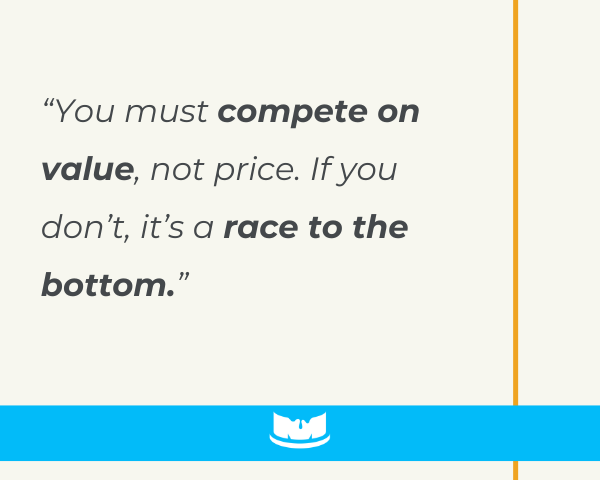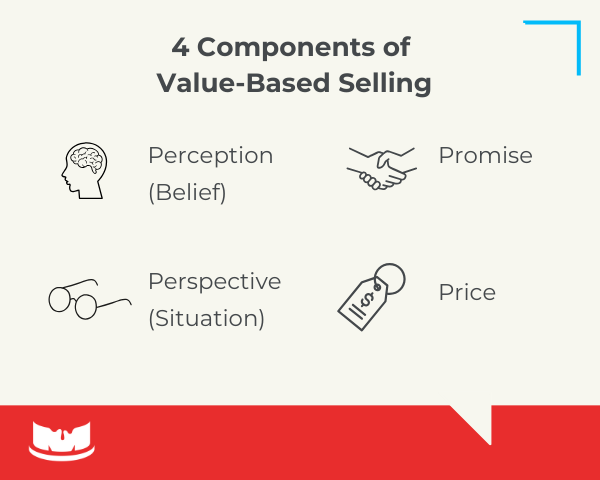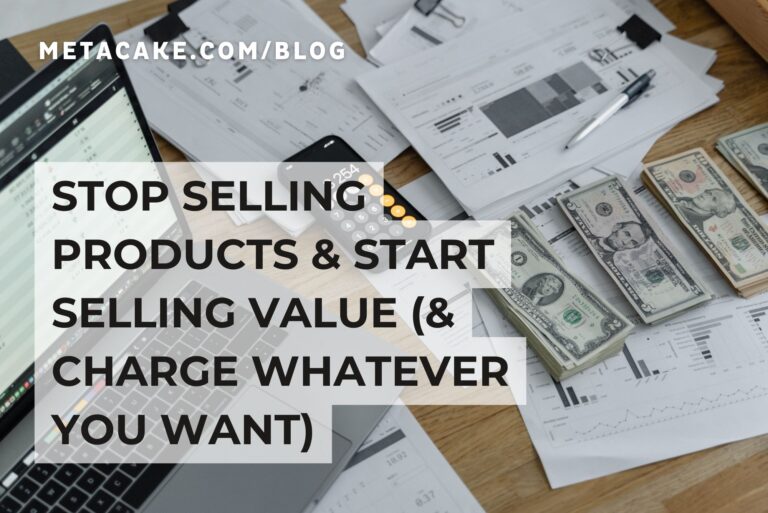If you want to build a valuable business, you have to focus on how to maximize profit long term.
In the ecommerce business equation, increasing the price of your products (not your AOV, but the actual price you charge) is critical for being able to generate more profit. We’re talking about value-based selling.
Unfortunately, most businesses struggle with value-based selling. They feel stuck under a price ceiling, chained down by competitors, market price, what prospects can afford, and what people seem “willing” to pay.
The problem is, pricing a product based on what customers can afford is completely backward. Think of it this way: People can find a way to afford almost any amount of money, assuming it’s worth the result.
Imagine there’s a magic machine that can double one million dollars. All you have to do is bring it a million bucks in the first place. Even if you didn’t have the money right now, wouldn’t you be motivated to find it?
Just as in that example, people measure your product against the result it provides. That result or benefit confers perceived value onto the product. Sure, competitor pricing and the market play roles in how you communicate that value, but the key is the customer-perceived value itself.
You must compete on value, not price. If you don’t, it’s a race to the bottom.

Below, learn why value-based selling is king and how to increase customer-perceived value so you can charge more.
Perception Is Everything: How to Build Value-Based Selling
Every product has the potential to move a person closer to a desired result in their life. The more desirable the result and the quicker the movement toward it, the more valuable the product.
The tricky part? People differ in their perception of what’s desirable.
There’s no universal value for any product or result because everyone assigns different values to different results. It all depends on how the customer interprets the results they want to achieve.
While that might sound complicated, it actually grants you a lot of leeway to increase the perceived value of your brand and/or product. If you can influence customer perception, then you have the tools to charge more for your products. That’s value-based selling.
Important note: People can, of course, employ this strategy dishonestly, marketing and selling products with no regard for the truth. We’re not talking about that here, if for no other reason than it’s not a winning long-term strategy for a successful business.
Since we all want to be good people and build valuable businesses, the way we implement value-based selling has to be backed up by the product and business. Otherwise, it simply self-destructs.
How to Increase the Perceived Value of Any Product or Service
Let’s use a quick illustration to unpack this.
What’s the value of a lighter to you? Probably not too high; they generally sell for a few dollars. But imagine you were stuck in the wilderness, and starting a fire was critical to your survival. That same lighter would be worth much more.
In the case of a lighter seller, the situation dictates the perceived value of the product. While the seller can’t force people into the woods just to sell fire starters, they can influence perceived value simply by crafting the right story around their product and communicating it effectively.
You can do this in four ways:

4 Components of Value-Based Selling
There are four components of value-based selling. By influencing each one, you elevate the perceived value of your product and business.
1. Perception (Belief)
Perception is what people believe to be true about a product. It’s the meaning THEY assign, regardless of what they’ve been told.
Your claim that a product helps customers achieve a desired result isn’t enough on its own. The customer must believe it’s true. In the example of the lighter, customers must believe the lighter CAN make fire. If they don’t believe that, the value is low.
Belief occurs on a spectrum; it’s not a yes or no. People need strong certainty about what a product can do for them. Since certainty is part of a spectrum, you can increase it.
How do you improve perception? Your brand is key. This sparks intrigue, communicates expertise, and builds trust — all of which improve the customer’s perception.
The story you tell about your brand and the product you’re selling is critical. Storytelling helps create a vision for your customers about how your product will help them achieve a result, again improving perception.
2. Perspective (Situation)
Perspective is the way someone views your product, and it’s based on their situation. One person will need or want a result more than another person. Think of perspective as the type of lens you look through, while perception is what you actually see through that lens.
How do you impact customer perspective? This is where understanding and defining your target market comes in.
First, when defining your target market, choose an audience in situations that lead them to highly value the results your product creates. To do this, you need to understand your audience’s desires, pain points, and present situation deeply. Then, use that to paint a compelling story that shows this group the value of your product for their situation.
For more about defining your target audience, read our guide on creating customer avatars.
Let’s go back to the example of the lighter. A customer might believe the lighter will make fire, but if they’re safe at home, they don’t value that result very highly. You need an audience who actually needs the result you’re selling.
Here’s another example: Say you sell silicone wedding rings for adventurous, active people that are safer than traditional bands. From the perspective of a man who works in an office, hires out his landscaping, rarely plays sports, and prefers reading at a coffee shop over rock climbing, paying $39.95 for a silicone ring makes zero sense.
For a carpenter, athlete, hunter, backpacker, etc., however, their situation changes their perspective. Their lifestyle can put them in harm’s way, and that silicone ring’s ability to rip under pressure could save their hand. Plus, the ring comes with an amazing branded experience that aligns with their desire for an adventurous life! From this audience’s perspective, the ring has a ton of value.
3. Promise
Promise is about what your product actually does. When selling products, the best promise wins — not the best product. People buy based on promise, and your product MUST fulfill it.
Promise is similar to perception in that promise helps define your customer’s belief about what the product can do. However, promise comes from you (the brand), while perception comes from the customer.
In the example of the lighter, the promise is that the lighter will start a fire, and it’s dependable enough to keep providing fire for a long time. That must be true for customers to purchase your lighter in the first place and for customers to keep buying from you over the long term.
So, how do you improve the promise of your product?
Communicate what the product will do for your customer with great conviction and great information or data. Associate this with what the customer cares about, likely either results or status, and explain in depth. Don’t assume things are obvious; leverage all the assets or benefits your product delivers to paint a clear vision and solid promise of value.
4. Price
Price is the last component of value-based selling. This is the sacrifice the customer must make to get your product and achieve the result it provides. As they view the product page and all its details, this is what they’re weighing in their head.
While cost includes money, it also includes elements like time and effort on the customer’s part.
In the example of the lighter, speed and reliability are important factors your audience can weigh against the cost. Without a lighter, customers might have to rub two sticks together for a long while, hoping for a spark. A lighter works instantly and predictably, which outweighs its monetary cost and motivates a sale for the outdoorsy.
To impact the price factor of value-based selling, consider how you position your product. Do you pit it directly against a competitor’s product or against the consequences of not buying it? Or of not buying it today?
Show customers the cost of putting off the results this product promises. And as mentioned, focus on total cost savings. Create a value stack that shows money spent vs. the time and effort customers save by buying this product today.
Understanding Value Changes the Way You Sell
Moving into value-based selling represents a powerful shift for businesses. By leveraging your product’s value and the four components to increase that value, you’ll discover much more freedom in pricing and much lower customer frustration.
Value-based selling depends on what information you communicate to your customers and how you present that information — through a great website, effective marketing, intentional email strategy, thoughtful packaging, and impactful content.
If you’re a six- to nine-figure ecommerce brand that would like to work with our team of experts to increase your brand’s growth and value, get in touch. We’d love to help.
